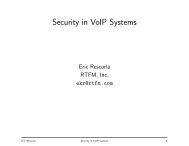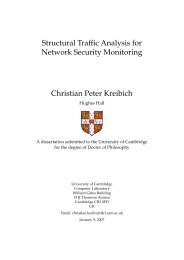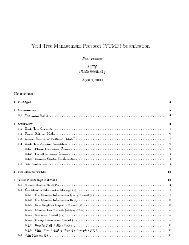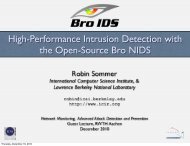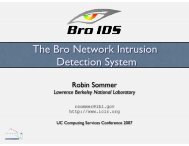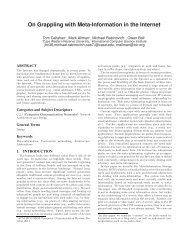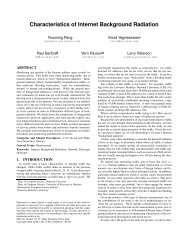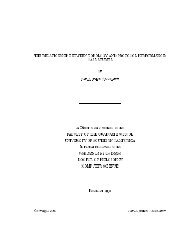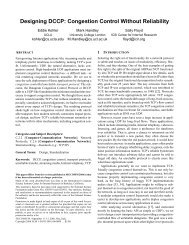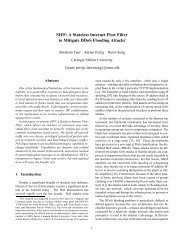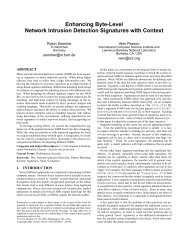WORM vs. WORM - The ICSI Networking and Security Group
WORM vs. WORM - The ICSI Networking and Security Group
WORM vs. WORM - The ICSI Networking and Security Group
You also want an ePaper? Increase the reach of your titles
YUMPU automatically turns print PDFs into web optimized ePapers that Google loves.
7. ACKNOWLEDGMENTS<br />
We would like to thank our shepherd, Nicholas Weaver,<br />
for his excellent comments <strong>and</strong> quick responses. We also<br />
thank the anonymous reviewers for their suggestions for improvement.<br />
8. REFERENCES<br />
[1] C. Carver, J. Hill, J. Surdu, <strong>and</strong> U. Pooch. A<br />
methodology for using intelligent agents to provide<br />
automated intrusion response. In Proceedings of the<br />
IEEE Systems, Man, <strong>and</strong> Cybernetics Information<br />
Assurance <strong>and</strong> <strong>Security</strong> Workshop, West Point, NY,<br />
June 6-7, 2000, pages 110–116, 2000.<br />
[2] Z. Chen, L. Gao, <strong>and</strong> K. Kwiat. Modeling the spread<br />
of active worms. In Proceedings, IEEE INFOCOMM,<br />
2003.<br />
[3] eEye Digital <strong>Security</strong>. Sapphire worm code<br />
disassembled. http:<br />
// www.eeye.com/ html/ Research/ Flash/ sapphire.txt,<br />
January 2003.<br />
[4] M. W. Eichin <strong>and</strong> J. A. A. Rochlis. With microscope<br />
<strong>and</strong> tweezers: An analysis of the internet virus of<br />
november 1988. In Proceedings of the 1989 IEEE<br />
Computer Society Symposium on <strong>Security</strong> <strong>and</strong><br />
Privacy, 1989.<br />
[5] J. Evers. Microsoft ponders automatic patching.<br />
InfoWorld (www.infoworld.com), August 2003.<br />
[6] R. Farrow. Reverse-engineering new exploits. CMP<br />
Network Magazine, 2004.<br />
[7] F. Gong. Next generation intrusion detection systems<br />
(IDS). McAfee Network <strong>Security</strong> Technologies <strong>Group</strong>,<br />
2002.<br />
[8] H. HexXer. Codegreen beta release<br />
(idq-patcher/antiCodeRed/etc.).<br />
http:// www.securityfocus.com/ archive/ 82/ 211428 ,<br />
September 2001.<br />
[9] G. Hoglund. Buffer overflow construction kit.<br />
http:// www.rootkit.com/ projects/ winblock, March<br />
2000.<br />
[10] J. O. Kephart, D. M. Chess, <strong>and</strong> S. R. White.<br />
Computers <strong>and</strong> epidemiology. IEEE Spectrum, 1993.<br />
[11] J. O. Kephart <strong>and</strong> S. R. White. Directed-graph<br />
epidemiological models of computer viruses. In<br />
Proceedings of the IEEE Symposimum on <strong>Security</strong> <strong>and</strong><br />
Privacy, 1991.<br />
[12] J. O. Kephart <strong>and</strong> S. R. White. Measuring <strong>and</strong><br />
modeling computer virus prevalence. In Proceedings of<br />
the IEEE Symposimum on <strong>Security</strong> <strong>and</strong> Privacy, 1993.<br />
[13] M. Kern. Re: Codegreen beta release<br />
(idq-patcher/antiCodeRed/etc.).<br />
http:// www.securityfocus.com/ archive/ 82/ 211462 ,<br />
September 2001.<br />
[14] C. Kreibich <strong>and</strong> J. Crowcroft. Honeycomb - creating<br />
intrusion detection signatures using honeypots. 2nd<br />
Workshop on Hot Topics in Networks (HotNets-II),<br />
2003.<br />
[15] J. Leyden. Blaster variant offers ’fix’ for pox-ridden<br />
pcs. http:// www.theregister.com/ 2003/ 08/ 19/<br />
blaster variant offers fix/ , August 2003.<br />
[16] LSD. Dcom exploit. http:<br />
// www.lsd-pl.net/ files/ get?WINDOWS/ win32 dcom,<br />
2003.<br />
[17] D. Moore. <strong>The</strong> spread of the code red worm.<br />
http:// www.caida.org/ analysis/ security/ code-red/<br />
coderedv2 \ analysis.xml.<br />
[18] D. Moore, V. Paxson, S. Savage, C. Shannon,<br />
S. Staniford, <strong>and</strong> N. Weaver. <strong>The</strong> spread of the<br />
sapphire/slammer worm.<br />
http:// www.cs.berkeley.edu/ ∼ nweaver/ sapphire/ ,<br />
2003.<br />
[19] D. Moore, C. Shannon, G. M. Voelker, <strong>and</strong> S. Savage.<br />
Internet quarantine: Requirements for containing<br />
self-propagating code.<br />
[20] T. Mullen. Defending your right to defend:<br />
Considerations of an automated strike-back<br />
technology.<br />
http:// www.hammerofgod.com/ strikeback.txt, October<br />
2002.<br />
[21] T. M. Mullen. Defending your right to defend:<br />
Considerations of an automated strike-back<br />
technology., October 2002.<br />
[22] R. Permeh <strong>and</strong> M. Maiffret. Codered analysis.<br />
http:// www.digitaloffense.net/ worms/ CodeRed/<br />
code-red-original-eeye/ , July 2001.<br />
[23] T. M. Project. Opcode db.<br />
http:// www.metasploit.com/ opcode search.html, 2003.<br />
[24] N. Provos. A virtual honeypot framework. CITI<br />
Technical Report 03-1, October 2003.<br />
[25] J. Rapoza. Cheese: If it’s good (worm), let it be!<br />
ZDNet India, July 2001.<br />
[26] G. Serazzi <strong>and</strong> S. Zanero. Computer virus propagation<br />
models. In 11th IEEE/ACM Symposium on Modeling,<br />
Analysis <strong>and</strong> Simulation of Computer <strong>and</strong><br />
Telecommunication Systems MASCOTS, 2003.<br />
[27] J. Shoch <strong>and</strong> J. Hupp. <strong>The</strong> worm programsearly<br />
experience with a distributed computation.<br />
Communications of the ACM, 25(3):172–180, 1982.<br />
[28] S. Staniford, V. Paxson, <strong>and</strong> N. Weaver. How to 0wn<br />
the internet in your spare time, 2002. To Appear in<br />
the Proceedings of the 11th USENIX <strong>Security</strong><br />
Symposium (<strong>Security</strong> ’02).<br />
[29] Symantec Corp. MSBlaseter, Symantec <strong>Security</strong><br />
Response. http:// securityresponse.symantec.com/<br />
avcenter/ venc/ data/ w32.witty.worm.html, 2004.<br />
[30] Symantec Corp. MSBlaseter, Symantec <strong>Security</strong><br />
Response. http:// securityresponse.symantec.com/<br />
avcenter/ venc/ data/ w32.blaster.worm.html, 2004.<br />
[31] Symantec Corp. Symantec <strong>Security</strong> Response.<br />
http:// securityresponse.symantec.com/ , 2004.<br />
[32] T. Vogt. Simulating <strong>and</strong> optimising worm propagation<br />
algorithms. http:<br />
// web.lemuria.org/ security/ WormPropagation.pdf ,<br />
February 2004.<br />
[33] A. Wagner, T. Dübendorfer, B. Plattner, <strong>and</strong><br />
R. Hiest<strong>and</strong>. Experiences with worm propagation<br />
simulations. In Proceedings of the 2003 ACM workshop<br />
on Rapid Malcode, pages 34–41. ACM Press, 2003.




